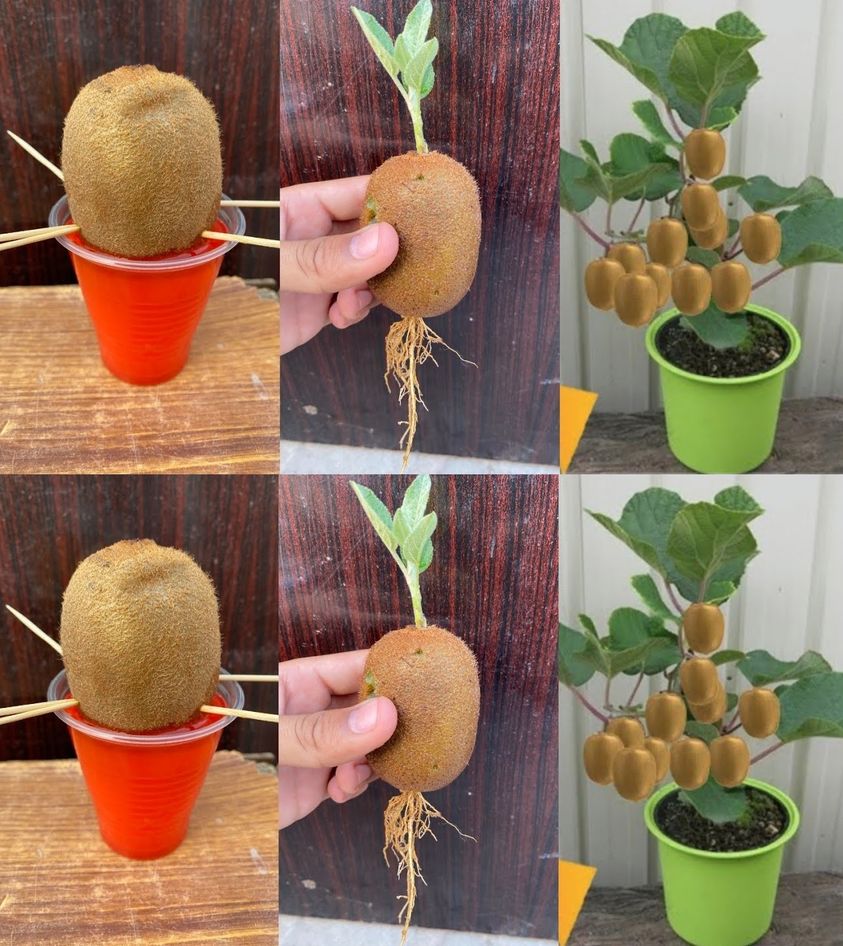Often, the mere mention of ‘kiwi’ evokes visions of juicy, fragrant slices. But did you know that you can nurture these delectable fruits right at your home, specifically in containers? The thrilling reality is that it’s entirely possible! Dive into the world of potted kiwi cultivation with this guide.
Delving into Hardy Kiwis
Frequently found on supermarket shelves, hardy kiwis are a tinier counterpart of the typical kiwi. A captivating characteristic of these fruits is that they are dioecious, which implies you’ll need at least one male plant for every group of 8-10 females to guarantee fruit production.

For novices, the Ananasnaya kiwi variety is often suggested due to its sturdy growth and abundant small fragrant fruits. The Geneva strain is ideal for early yields, while the Dumbarton Oaks is celebrated for its plentiful harvest. If larger fruits are your preference, especially in cooler climates like USDA Zone 5, consider the Michigan State variety. The Ken’s Red boasts a beautiful red hue, and the Issai variety stands out for its self-pollination feature, eliminating the need for both genders.
Starting Your Kiwi: Seeds or Stem Cuttings?
There are two primary ways to propagate kiwis: using seeds or stem cuttings. Regardless of the method, a touch of patience is required as the plant typically takes 3 to 5 years to bear its first fruit. While seeds are available from nurseries or online platforms, opting for cuttings often produces superior plants. And if fruiting vines are your goal, ensure you plant both male and female specimens.
Pro Tip: For a head start, you might want to buy a pre-potted kiwi plant from a nursery, ideally a variety that self-pollinates.
Choosing the Ideal Pot

Kickstart your kiwi cultivation in a pot ranging from 12-14 inches, equipped with adequate drainage openings. As the plant matures and outpaces its initial home in a few years, transition it to a more spacious container, ensuring the roots remain intact.
Sturdy Support is Key
With the potential to stretch up to 25-30 feet, kiwi vines demand reliable support. Guiding them to ascend a patio structure or setting up a robust trellis can be effective. Alternatively, spacious balconies or rooftops are also great locations for kiwi cultivation.
Essentials for Cultivating Potted Kiwis

Soil Composition
For prosperous growth, kiwi plants favor a blend of well-aerated soil that leans towards loam and contains a touch of organic additives like compost, decomposed leaves, or seasoned manure. The ideal pH spectrum ranges from slightly acidic to mildly alkaline. Soils that are overly clayey or too sandy should be avoided.
Preferred Setting
Healthy kiwi growth mandates a generous dose of sunlight, optimally spanning 5 to 6 hours daily.
Temperature Parameters
For chillier regions, temperatures oscillating between 40º-60º F (4.44º-15.56º C) are perfect. Conversely, for toastier climates, a bracket of 56º-77º F (13.33º-25º C) is suitable. It’s vital to note that young kiwi plants might suffer damage or perish in temperatures plummeting below 14º F (-10º C).
Hydration Needs
Consistent moisture in the soil propels optimal kiwi growth. However, drenching the soil or allowing the plant’s roots to wade in stagnant water may induce root decay.
Nutrient Supplements
Once the kiwi plants find their footing, periodic nutrient supplementation becomes imperative. Nevertheless, over-nourishing can jeopardize the fragile root system. Employing a well-balanced granular feed, like a 16-16-16 mix, 2-3 times annually as per the recommended dosage, usually suffices.
Tending to Your Kiwi Plant Trimming Practices

Yearly trimming of kiwi vines is a non-negotiable. The ideal pruning window for female specimens is the dormant winter phase, whereas male plants should be clipped post-flowering. Self-fertilizing variants also benefit from winter trims.
Soil Covering
To retain moisture in the soil, mulching is recommended. A concoction of compost or fragmented leaves is effective. However, ensure it’s not directly touching the vine’s base to avert potential rot.
Guarding Against Pests and Ailments
Kiwi plants are generally resilient against pests and maladies. Should any issues surface, a natural remedy like neem oil often resolves them. If furry friends, especially felines, roam your space, safeguard your plant.
Winter Care for Kiwis
Though full-grown kiwi plants can withstand a deep freeze of up to -15 F (-26 C), juvenile plants benefit from winter protection to enhance fruit caliber. When indoors, swaddle the vines with fabric while ensuring they still get a bit of sunlight.
Reaping and Preserving Kiwis

Seed-propagated kiwi plants usually commence fruit-bearing around their third year. Some strains, such as the Arctic, fruit sooner. Once in its prime, a kiwi vine can generously offer 40-50 pounds of fruit annually for nearly half a century!
A softening texture indicates fruit maturity. A taste test can confirm their readiness. Post-harvest, kiwis can be chilled for up to five weeks.
